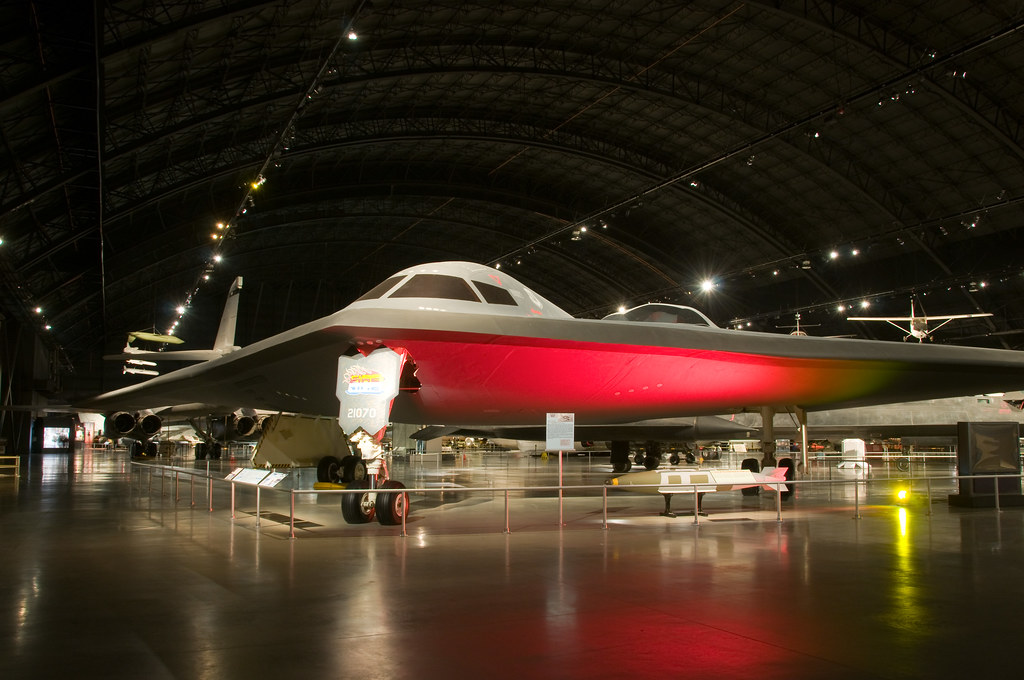 The Northrop Grumman B-2 Spirit (also known as the Stealth Bomber) is an American heavy bomber with "low observable" stealth technology designed to penetrate dense anti-aircraft defenses and deploy both conventional and nuclear weapons. Because of its considerable capital and operations costs, the project was controversial in Congress and among Pentagon brass. During the late 1980s and early 1990s, Congress slashed initial plans to purchase 132 bombers to just 21. The cost of each aircraft averaged US$737 million in 1997 dollars. Total procurement costs averaged US$929 million per aircraft, which includes spare parts, equipment, retrofitting, and software support. The total program cost, which includes development, engineering and testing, averaged US$2.1 billion per aircraft (in 1997 dollars). Twenty B-2s are operated by the United States Air Force. Though originally designed in the 1980s for Cold War operations scenarios, B-2s have been used in combat to drop bombs on Serbia during the Kosovo - Serbia Conflict in the late 1990s, and see continued use during the ongoing wars in Iraq and Afghanistan. One aircraft was lost when it crashed on takeoff in 2008.
The Northrop Grumman B-2 Spirit (also known as the Stealth Bomber) is an American heavy bomber with "low observable" stealth technology designed to penetrate dense anti-aircraft defenses and deploy both conventional and nuclear weapons. Because of its considerable capital and operations costs, the project was controversial in Congress and among Pentagon brass. During the late 1980s and early 1990s, Congress slashed initial plans to purchase 132 bombers to just 21. The cost of each aircraft averaged US$737 million in 1997 dollars. Total procurement costs averaged US$929 million per aircraft, which includes spare parts, equipment, retrofitting, and software support. The total program cost, which includes development, engineering and testing, averaged US$2.1 billion per aircraft (in 1997 dollars). Twenty B-2s are operated by the United States Air Force. Though originally designed in the 1980s for Cold War operations scenarios, B-2s have been used in combat to drop bombs on Serbia during the Kosovo - Serbia Conflict in the late 1990s, and see continued use during the ongoing wars in Iraq and Afghanistan. One aircraft was lost when it crashed on takeoff in 2008.
Northrop B-2 Spirit. The aircraft on display was constructed without engines or instruments for fatigue testing.
As with the B-52 Stratofortress and B-1 Lancer, the B-2 provides the versatility inherent in manned bombers. Like other bombers, its assigned targets can be canceled or changed while in flight, the particular weapon assigned to a target can be changed, and the timing of attack, or the route to the target can be changed while in flight. In addition, its low-observable, or "stealth", characteristics give it the ability to penetrate an enemy's most sophisticated anti-aircraft defenses to attack its most heavily defended targets.
The prime contractor, responsible for overall system design, integration and support, is Northrop Grumman. Boeing, Raytheon (formerly Hughes Aircraft), G.E. and Vought Aircraft Industries, are subcontractors. The blending of low-observable technologies with high aerodynamic efficiency and large payload gives the B-2 significant advantages over previous bombers. The U.S. Air Force reports its range as approximately 6,000 nautical miles (6,905 mi (11,113 km). Also, its low-observation ability provides the B-2 greater freedom of action at high altitudes, thus increasing its range and providing a better field of view for the aircraft's sensors. It combines GPS Aided Targeting System (GATS) with GPS-aided bombs such as Joint Direct Attack Munition (JDAM). This uses its passive electronically scanned array APQ-181 radar to correct GPS errors of targets and gain much better than laser-guided weapon accuracy when "dumb" gravity bombs are equipped with a GPS-aided "smart" guidance tail kit. It can bomb 16 targets in a single pass when equipped with 1,000 or 2,000-pound (450 kg or 900 kg) bombs, or as many as 80 when carrying 500 lb (230 kg) bombs.
The B-2's stealth comes from a combination of reduced acoustic, infrared, visual and radar signatures, making it difficult for opposition defenses to detect, track and engage the aircraft. Many specific aspects of the low-observability process remain classified. The B-2's low observability originates from stealth technology exploited for the F-117. Russian-born physicist and mathematician Pyotr Ufimtsev, whose theoretical work made the F-117 and B-2 possible, was hired by Northrop at one time. Additionally, the B-2's composite materials, special coatings and flying wing design, which reduces the number of leading edges, contribute to its stealth characteristics. Each B-2 requires a climate-controlled hangar large enough for its 172-foot (52 m) wingspan to protect the operational integrity of its sophisticated radar absorbent material and coatings. The engines are buried within the wing to conceal the induction fans and hide their exhaust.The original B-2 design had tanks for a contrail-inhibiting chemical, but this was replaced in the final design with a contrail sensor from Ophir that alerts the pilot when he should change altitude and mission planning also considers altitudes where the probability of contrail formation is minimized. The B-2 has a crew of two: a pilot in the left seat, and mission commander in the right.[4] The B-2 has provisions for a third crew member if needed. For comparison, the B-1B has a crew of four and the B-52 has a crew of five. B-2 crews have been used to pioneer sleep cycle research to improve crew performance on long sorties. The B-2 is highly automated, and, unlike two-seat fighters, one crew member can sleep, use a toilet or prepare a hot meal while the other monitors the aircraft.

No comments:
Post a Comment